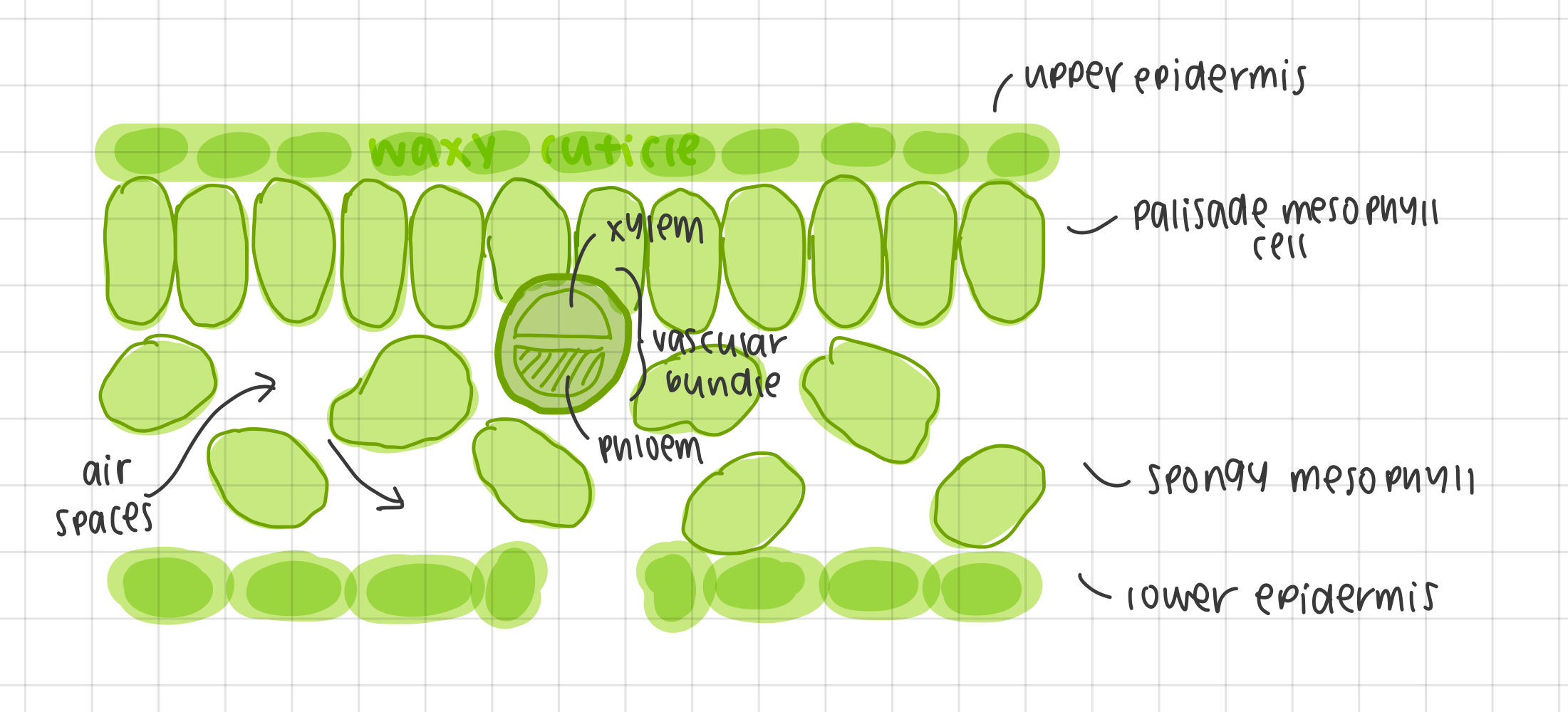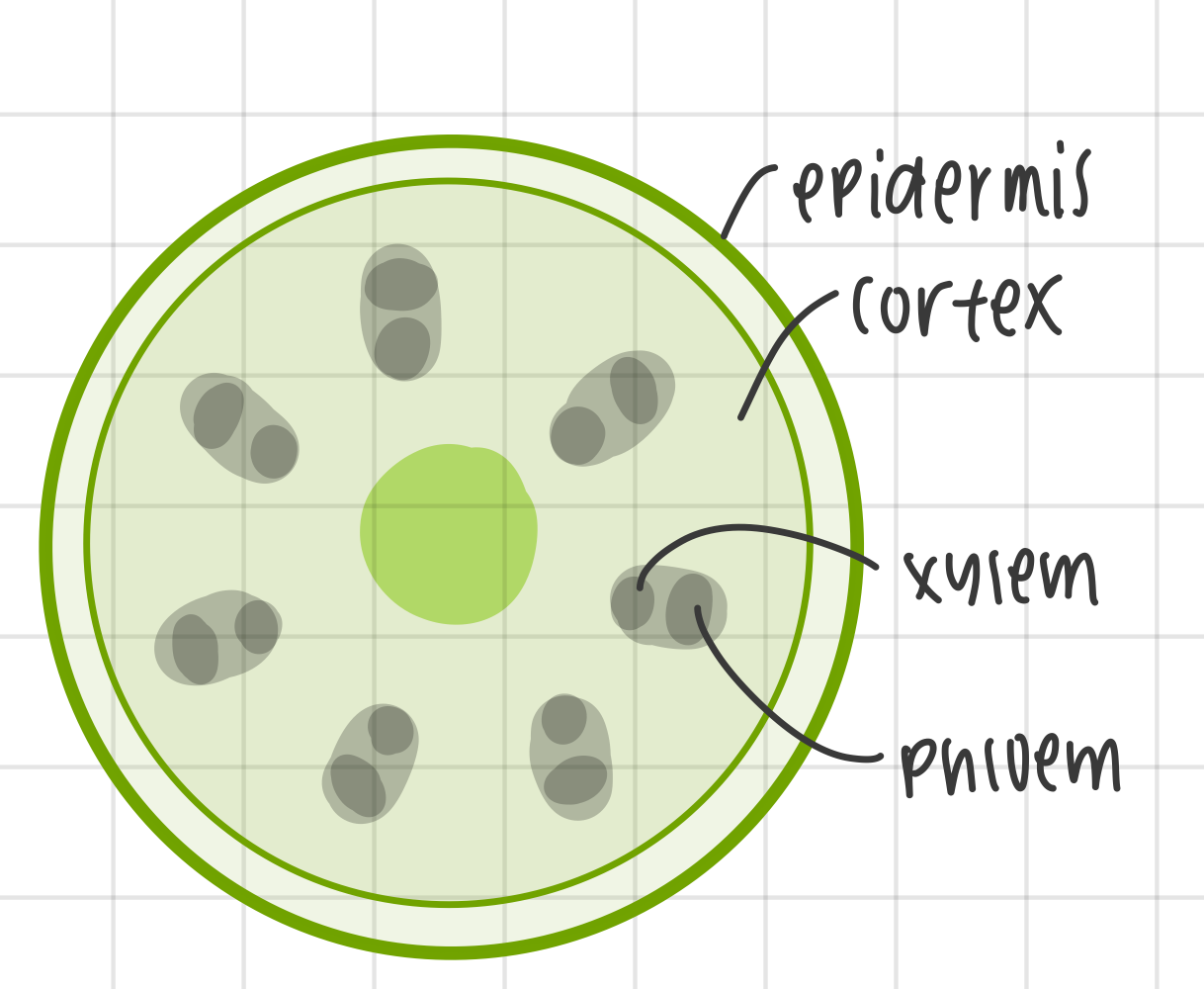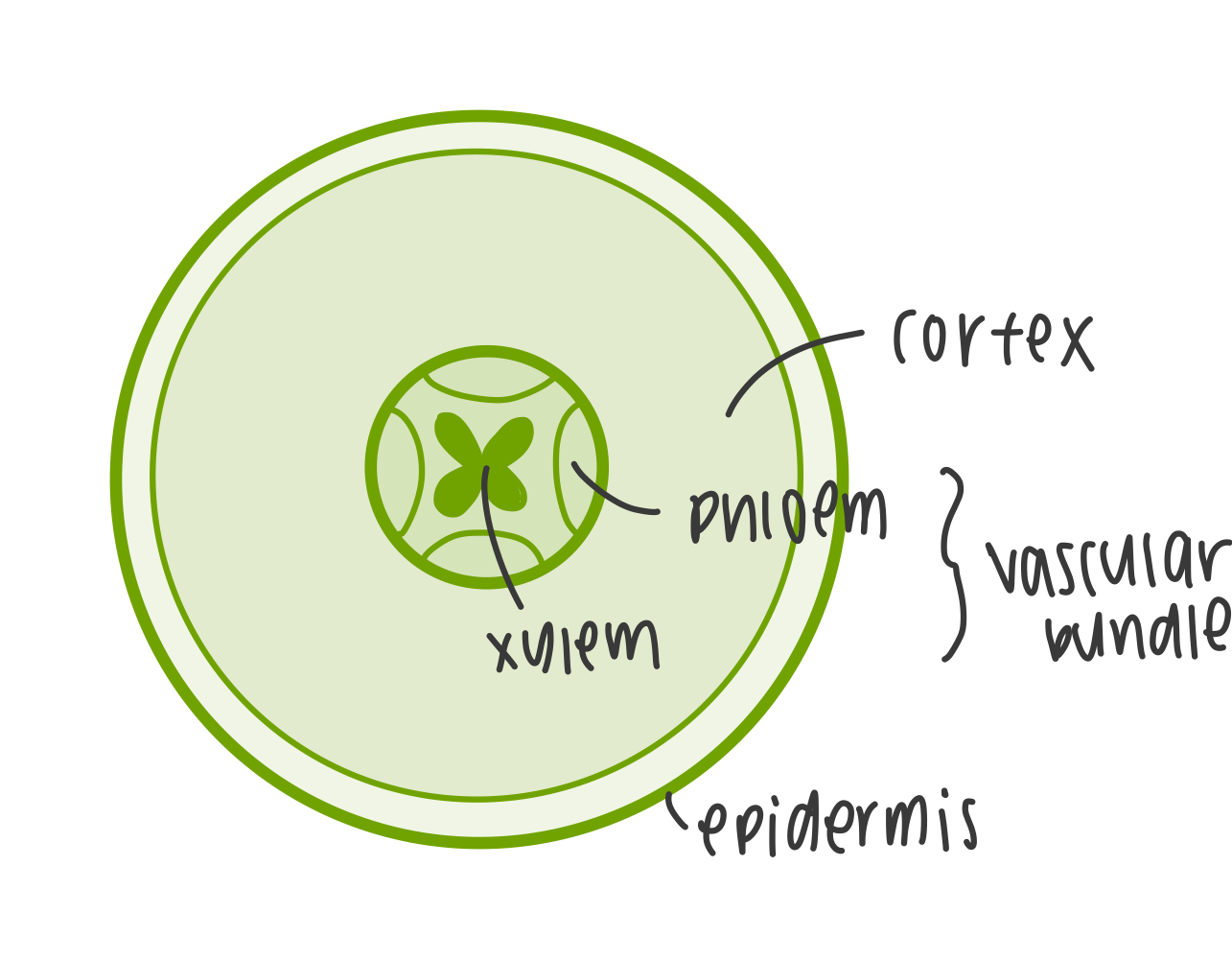B3.1/B3.2 GAS EXCHANGE AND TRANSPORT IN (PLANTS) and some water A1.1
1/17
Earn XP
Description and Tags
PLANTZZZ
Name | Mastery | Learn | Test | Matching | Spaced |
|---|
No study sessions yet.
18 Terms
outline the function of leaves in plants
photosynthesis
leaves contain chlorophyll, captures sunlight to convert carbon dioxide and water into glucose and oxygen
important for providing environment with oxygen and food
gas exchange
occurs in the stomata to allow for exchange of gases
vital for photosynthesis and respiration
outline the structure of a leaf

outline the adaptations of leaves for gas exchange
branched veins, containing xylem to transport water throughout the plant
epidermis provides a protective single layer of cell which produces a waxy cuticle which is hydrophobic (lipid layer) to prevent water loss by evaporation from the plant
stomatal guard cells can open and close to regulate gas exchange
spongy mesophyll transports water from xylem and provides large surface area for evaporation, also creating air spaces which enhances gas exchange (diffusion of gases between environment and cells)
outline the adaptations of guard cells in leaves
can open and close, allowing for controlling the regulation of gas exchange and transpiration
open: allow diffusion of CO2 in for photosynthesis which allows for transpiration of H2O out (excess oxygen from photosynthesis is also released)
closed: prevents water loss, no CO2 into the leaf = no photosynthesis occurring
outline the adaptations of xylem in leaves
rigid walls:
thickened cellulose made up of polymers called lignin prevents vessels from collapsing from the low internal pressure when the plant is transpiring
continuous/hollow tubules:
continuous, hollow tubes that facilitate the upward movement of water and dissolved minerals from the roots to the leaves
hollow structure allows for efficient transport without obstruction
pits:
lignified walls have pits which are impermeable to water allowing for water to enter and exit
outline the structure of a stem

outline the structure of a root

outline the functions of structures in the stem/root
epidermis:
provides physical protection
reduces water loss with waxy cuticle
may contain specialised structures
cortex:
stores carbohydrates/nutrients
provides structural support
facilitates transport of water and nutrients
xylem:
transports water and mineral ions from the root to the rest of the plant
phloem:
transports organic nutrients produced (glucose, during photosynthesis)
regulates plant metabolism
outline transpiration plants
process by which water is transported from the roots of a plant to its leaves where it will be evaporated into the atmosphere
passive process, does not require ATP
transports water / nutrients (mineral ions)
what this does to the plant:
provide cooling effect
prevent overheating/regulate temp
allow for nutrient transport
movement of dissolved nutrients in water from roots to leaves through capillary action in xylem vessels
allow for water regulation
maintain turgor pressure in plant cells which is essential for structural integrity of plant
outline the factors affecting the rate of transpiration
temperature: increased temperature increases transpiration rate
increases the evaporation and diffusion due to the higher kinetic energy of water molecules at elevated temperatures
humidity: increased humidity decreases transpiration rate
this decreases the water vapor concentration gradient between the air spaces and the atmosphere, decreasing overall diffusion of water vapor from the leaf to the surrounding air
wind: increased wind increases the transpiration rate
removes the boundary layer of humid air that surrounds the leaf, lowering the humidity near the stomata which increases the concentration gradient for water vapor
light: increased light increases transpiration rate
presence of light increases photosynthesis, stimulating guard cells to open for carbon dioxide
explain the process of transpiration
water is evaporated into vapor in the spongy mesophyll by light energy absorbed by the leaf
the vapour diffuses out of the leaf via stomata
this creates a negative pressure gradient in the leaf, drawing h2o out of xylem vessels by capillary action (which is the passive movement of water against gravity), creating tension
this tensions draws h2o up the xylem vessels creating a continuous stream via mass flow
water molecules are pulled up the xylem by cohesion, the force that holds polar water molecules together through hydrogen bonds
water molecules are also adhesive, sticking to the polar xylem walls, which helps facilitate their movement upward
negative pressure that pulls water upward from the roots to the xylem is generated by actively transporting mineral ions into the root cell
creates a high concentration gradient inside the cells and a low concentration gradient in the soil, allowing water to diffuse into the roots via osmosis, which contributes to positive pressure
explain the generation of root pressure in xylem vessels by active transport of mineral ions
mineral ions are actively transported into the root which decreases internal water potential
water moves from high water potential to low water potential via osmosis so from the soil to root
the influx of water into the root causes a high root pressure creating a positive pressure potential to push the water upwards through the xylem in roots and stems
root pressure tends to be generated when transpiration is insufficient
night (lower temperatures, decreased light intensity)
high humidity levels (decrease concentration gradient)
spring season, before leaves have opened
root hairs are lateral extensions of root epidermal cells to increase surface area for water/nutrient uptake
outline translocation and what this does for the plant
translocation is the bidirectional transport of organic compounds from source to sink via the phloem
source: plant organ where organic compounds are synthesised or stored
sink: plant organ that uses or stores organic compounds
outline the role of phloem in translocation
vascular tissue in plants that translocates phloem sap which is a fluid containing water, minerals and carbon compounds
composed of living cells (sieve tube elements and companion cells)
outline the adaptations of phloem sieve tubes and companion cells
phloem sieve tubes
specialised cells connected end to end to form phloem sieve tubes
these cells have a reduced cytoplasm and limited organelles and no nucleus to maximise space for transporting the sap
companion cells:
provide metabolic support for sieve tube cells as it synthesises ATP and enzymes required for its processes
contains many mitochondria to synthesise ATP to load materials at source and unload at sink
contain multiple plasmodesmata which are connection channels between companion and sieve cells for the transport of materials
explain the process of translocation
loading at source
solutes (sucrose) are actively transported from the source into companion cells via proton pumps which create a proton gradient
these solutes then travel thru the plasmodesmata into the sieve tube cells, lowering the water potential
water from the xylem is transported into phloem sieve tubes through osmosis, increasing the hydrostatic pressure in phloem
hydrostatic pressure
this process creates a high hydrostatic pressure at the source than the sink therefore water will flow down the sieve tube cells along with the solutes from a high to low pressure gradient
unloading at sink
after travelling down phloem, solutes are unloaded by companion cells into sinks through active or passive transport
as the concentration of solutes decrease, the water pressure also decreases resulting in water to transfer from the phloem to the xylem by osmosis, decreasing the hydrostatic pressure in the phloem
solutes in the sink (root cells) are metabolised or stored in vacuoles
outline how water is transported in the xylem
transpiration creates negative pressure/tension that pulls water upwards → can be explained by 2 properties: adhesion and cohesion
water is cohesive
water’s cohesiveness, caused by hydrogen bonds, causes molecules to form an unbroken column, allowing for the movement from roots to leaves
water is adhesive with xylem walls
water is attracted to the hydrophilic walls of xylem due to adhesion, allowing for the anchoring of water columns to the xylem walls
as a result, cohesion keeps the water molecules connected, forming a column, allowing for the adhesion of molecules up the hydrophilic walls, moving the entire column upwards all together, creating a continuous flow of water from the roots to leaves against gravity
using water as an example, explain its role as a medium for metabolism and for transport in plants and animals
water is a universal solvent → it is polar
like dissolves like = hydrophilic/polar molecules and charged molecules such as mineral ions all dissolve in water
this allows for the efficient transport of molecules in water